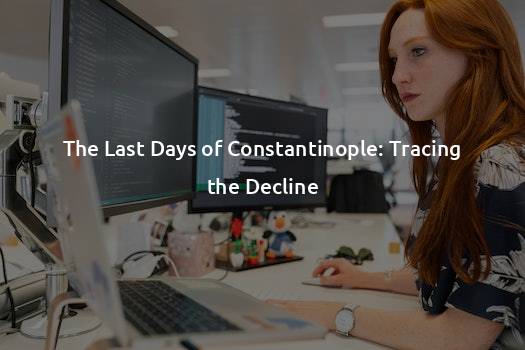The Last Days of Constantinople: Tracing the Decline
The Last Days of Constantinople: Tracing the Decline
Constantinople, once a symbolic and thriving city, witnessed its last days in the spring of 1453. This ancient city, often referred to as the Byzantine Empire’s capital, had withstood countless sieges over the centuries. However, the decline that ultimately led to its fall was the culmination of a complex web of political, military, and social factors. Join us as we retrace the decline of Constantinople, shedding light on the events that marked its final days as a Byzantine stronghold.
The Political Landscape
The Byzantine Empire, at the eve of its decline, was facing internal instability and external threats. The empire had experienced waves of conflicts, both internal and with neighboring powers, weakening its political structure. The rivalry between Byzantine nobles and the inability of emperors to maintain effective control over their vassals left the empire vulnerable.
One of the significant challenges plaguing the Byzantine Empire was the rising power and ambitions of the Ottoman Turks. The Ottomans, under the capable leadership of Sultan Mehmed II, sought to expand their territories and establish dominance over Constantinople.
The Siege of Constantinople
With the Ottomans laying siege to Constantinople, the city faced its most critical and punishing days. The Byzantines, led by Emperor Constantine XI, displayed unparalleled resilience in the face of overwhelming odds. The city walls and fortifications were impressive, but they were no match for the overwhelming Ottoman forces.
The Ottomans strategically cut off supply routes to the city, starving its inhabitants. The Byzantines, in desperation, sought aid from Western Europe, but their pleas fell on deaf ears. The Eastern Orthodox Church, which had played a vital role in the lives of the people of Constantinople, continued to provide spiritual and emotional support during these trying times.
After a grueling 53-day siege, the inevitable occurred. On May 29, 1453, the Ottoman forces successfully breached the city’s defenses, leading to a massacre and the fall of Constantinople. The Byzantine Empire, which had stood for a thousand years, finally came to an end.
The Aftermath
The capture of Constantinople by the Ottomans had wide-reaching consequences. The fall of this great city not only marked the end of the Byzantine Empire but also had a profound impact on the rest of Europe.
The Ottoman Empire, now in control of Constantinople, continued its expansion into Europe, striking fear in the hearts of many. The fall of Constantinople also played a significant role in stimulating the Age of Discovery, as European powers sought new maritime routes to bypass Ottoman-controlled territories.
The human cost of the fall of Constantinople cannot be overlooked. Scholars, artists, and intellectuals fled the city, seeking refuge in other parts of Europe. Their exodus contributed to the spread of Byzantine scholarship, inspiring the Renaissance and paving the way for the preservation of ancient knowledge.
TLDR;
The last days of Constantinople were marked by a decline resulting from political instability, rivalries, and external threats. The siege of Constantinople by the Ottomans in 1453 spelled the end for the Byzantine Empire. The fall of the city had far-reaching consequences, leading to Ottoman expansion and inspiring the Age of Discovery. However, the city’s fall also served as a catalyst for the preservation and dissemination of Byzantine knowledge, contributing to the Renaissance.







